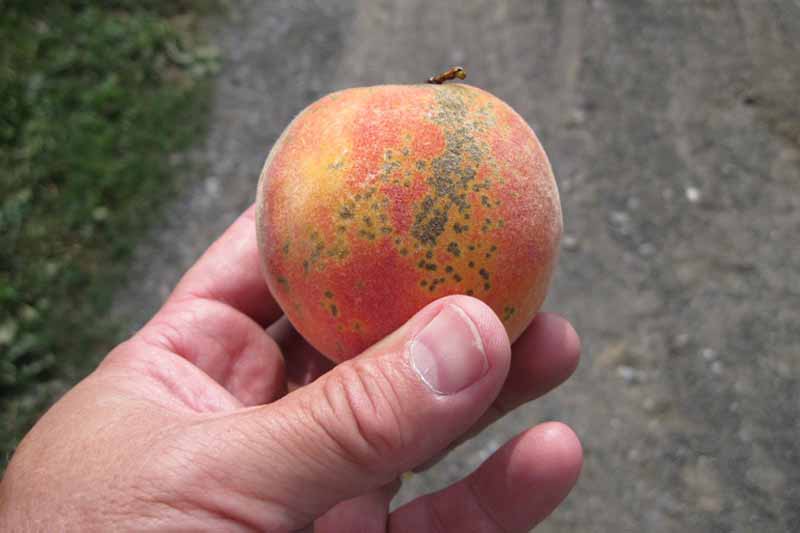The fungus that causes scab, Cladosporium carpophilum, is responsible for scab on peaches, apricots, nectarines, and plums. Scab is usually much more of a problem for home gardeners than in commercial orchards. This is because the trees are typically sprayed with fungicides in commercial operations, and they eliminate the scab before it can get a foothold. We link to vendors to help you find relevant products. If you buy from one of our links, we may earn a commission. Since understanding the disease cycle of scab will help to cure this foul looking disease, we’ll provide you with the steps to take to keep this disease from attacking your stone fruit trees.
Infection on the Fruit and Twigs
Your first indication that scab is on the march will be small, round, green spots on the fruit. These lesions are more common on the side of the fruit facing the sun, or on the stem side. The lesions can merge to form large brown blotches on apricots, or black ones on peaches, nectarines, and plums. Unfortunately, this disease is often not noticed until the crop is almost fully developed. Fruit with severe infections may crack open or be stunted and misshapen. When cracking occurs, other fungi can invade and then cause rot or other issues. The crop continues to be susceptible until harvest. In addition to the edible produce, this fungus can also infect the twigs at the same time. These infections result in slightly raised blotches up to 1/4 inch in diameter. In rare cases, the twigs die back. The leaves, too, can be infected.
Twigs Serve as a Source of Infection
The scab fungus overwinters in lesions in the twigs and can produce large numbers of spores. These spores stay put until it becomes moist. Then, windblown mist and splashing rain spreads it to the developing fruit, leaves, and twigs. The spores germinate most effectively at 65-75°F. However, infection can occur between 37 and 95°F. The lesions on the twigs produce spores throughout the season, starting shortly after petal fall and continuing until late autumn. And it gets worse! The spores in the lesions on the fruit re-infect the twigs and leaves.
Cultural Controls
Since the infected twigs serve as such an enormous source of infection, you should remove and destroy them in the early spring before growth starts. Destroy any unwanted or wild apricots, plums, peaches, or nectarines that are near your tree. Prune your tree each year, so that the air will circulate well. Shady, moist canopies are likely to produce more severe infections. Unfortunately, there are no apricot, peach, plum, or nectarine varieties that are resistant to scab. This may not help you when you are already battling this infection, but if you plan to plant a new fruit tree, be sure to avoid areas that are low lying or shaded.
Control with Fungicides
Consider using fungicide sprays that are approved for fruit trees. The most important time to spray is from the petal fall until 40 days before harvest. You should spray every 10-14 days until one month before harvest if you will be spraying for brown rot. If you will not be, you should continue spraying for scab until harvest. These final sprays are important to reduce late-season infections of scab on the twigs, fruit, and leaves.
Remember That the Symptoms on Your Fruit are Superficial
While apricot or peach scab symptoms may look horrible, you can generally get rid of them by peeling the produce. You won’t be able to sell it, but it will still be edible. You should take precautions to prevent stone fruit scab because moderate levels can build up to high levels during the first two years of tree growth without your knowledge. If that happens, you can get sudden severe infections of the fruit when they are produced in the third year of growth. If the cultural methods for control don’t work, you may need to apply fungicides to control scab. Have you been faced with scab on your apricots, peaches, nectarines, or plums? If so, tell us how you fared in the comments. And for more information on growing fruit trees, check out some of our other guides:
How Far Apart Should I Space Fruit Trees? How to Prepare Fruit Trees for Winter How to Grow Dwarf Citrus Trees
Photo by Photo courtesy of Thomas G. Ford, Penn State Extension, reprinted with permission.
